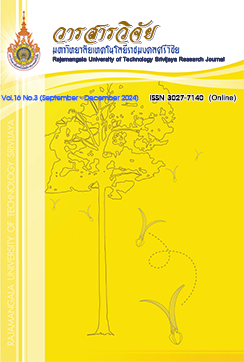Development of Algorithm for Smart Cricket Farms with Deep Sleep Mode
Keywords:
smart farm, energy saving, algorithm, deep sleep mode (DSM)Abstract
Smart farming is an agricultural innovation that has been increasingly applied to modern agriculture because it can increase production efficiency, reduce costs, and control production quality. It can also be used for monitoring environmental control data which is an important variable in plant cultivation. Since the control system is operated 24 hours a day, such applications consume a lot of electricity. Therefore, this research aimed to develop an algorithm that could reduce power consumption by at least 20% for use in a smart farm system without changing or adding equipment from the original smart farm. An improved algorithm was used to control the output from the original smart farm system with an algorithm to monitor changes in inputs such as temperature and humidity over time in each season, in combination with Deep Sleep Mode (DSM). In addition, it was designed to be compatible with database systems and to display web pages through a wireless network browser to monitor the operation in real time. From a 40-day comparative test on electricity usage between the original smart farm system and the developed smart farm system, it was found that the original smart farm system consumed 42.25 kWh of electricity and the proposed smart farm system consumed 21.04 kWh. The electric power consumption of the developed smart farms system decreased by 21.21 kWh, representing a 50.20% reduction compared to the original smart farms system. In addition, crickets raised in both systems showed similar growth. Therefore, it can be concluded that the algorithm developed, when applied to control the operation of the smart farm system, can effectively reduce electricity consumption.
References
Ahmed, N., De, D. and Hussain, I. 2018. Internet of Things (IoT) for smart precision agriculture and farming in rural areas. IEEE Internet of Things Journal 5(6): 4890-4899.
Antony, A.P., Leith, K., Jolley, C., Lu, J. and Sweeney, D.J. 2020. A Review of Practice and Implementation of the Internet of Things (IoT) for Smallholder Agriculture. Sustainability 12(9): 1-19.
Boonchieng, E., Chieochan, O. and Soakeaeew, A. 2018. Smart Farm: Applying the use of NodeMCU, IOT, NETPIE and LINE API for a Lingzhi Mushroom Farm in Thailand. The IEICE Transactions on Communication 101(B): 16-23.
CircuitDigest. 2019. Arduino Sleep Modes and How to use them to Save the Power. How to use arduino sleep modes. Available Source: https://circuitdigest.com/microcontroller-projects/arduino-sleep-modes-and-how-to-use-them-to-reduce-power-consumption, December 10, 2021.
Department of Livestock Development. 2021. The People's Guide to Raising Crickets. Available Source: https://region6.dld.go.th/ webnew/ images/Z016.pdf, May 29, 2023.
Doshi, J., Patel, T. and Bharti, S.K. 2019. Smart Farming using IoT, a solution for optimally monitoring farming conditions. Procedia Computer Science 160: 746-751.
Giang, L.T.H. 2020. IoT Ticket Using RESTful. Bachelor of Engineering (Technology and Communication), Vaansan Ammattikorkeakoulu, VAMK University of Applied Sciences.
Jansom, T. 2020. The Effect of Different Diets on the Growth, Reproductive Rate and Protein Content of the Two-spotted Cricket (Gryllus bimaculatus de Geer). Master of Science (Entomology), Kasetsart University.
Jeepet, S. and Sudharatna, Y. 2017. Industrial 4.0 technology adoption applying to small agriculture farm. Master of Business Administration, Kasetsart University. (in Thai)
Kanjanawanishkul, K., Kaewsihawong, J., Uttaracha, W. and Yangyuen, S. 2020. Smart Cricket Farming Based on Internet of Things. Farm Engineering and Automation Technology Journal 6(2): 98-112. (in Thai)
Lakshmisudha, K., Hegde, S., Kale, N. and Iyer, S. 2016. Smart Precision Based Agriculture Using Sensors. International Journal of Computer Applications 146(11): 36-38.
Kuzminykh, I., Carlsson, A. and Yevdokymenko, M. 2019. A Performance Evaluation of Sensor Nodes in the Home Automation System based on Arduino, pp. 1-6. In Problems of Info communications. Science and Technology 2019 International Scientific-Practical Conference. Kyiv, Ukraine.
Meteorological Department. 2021. Agrometeorological Report October 2020. Weather Report No. 551.586-02-2021. Available Source: http://www. arcims.tmd.go.th, October, 20, 2021.
Namhormchan, T. and Muangchan, N. 2020. Energy Conservation in the Closed-System Greenhouse. EDU Heritage Journal Science and Technology 14(1): 1-13. (in Thai)
Thongpan, N. and Therengphak, T. 2020. Automatic Watering Systems via Wireless Sensor Network. Journal of Inovative Technology Management Rajabhat Maha Sarakham University 3(1): 36-43. (in Thai)
Tudose, D.S., Marin, A. and Geanta, M. 2016. Adaptive duty-cycling algorithms for efficient energy harvesting in wireless sensor networks, pp. 1-6. In 2016 15th RoEduNet Conference: Networking in Education and Research. University Politehnica Bucharest, Romania.
Xu, L., O’Hare, G.M.P. and Collier, R. 2017. A smart and balanced energy-efficient multihop clustering algorithm (smart-beem) for mimo iot systems in future networks. MDPI Sensors (Basel) 17(7): 1574-1597.
Zhang, N., Wang, M. and Wang, N. 2002. Precision agriculture-a worldwide overview. Computers and electronics in agriculture 36 (2-3): 113-132.
Downloads
Published
How to Cite
Issue
Section
License
Copyright (c) 2024 Rajamangala University of Technology Srivijaya Research Journal

This work is licensed under a Creative Commons Attribution-NonCommercial-NoDerivatives 4.0 International License.
The content and information in the article published in Journal of Rajamangala University of Technology Srivijaya It is the opinion and responsibility of the author of the article. The editorial journals do not need to agree. Or share any responsibility.







